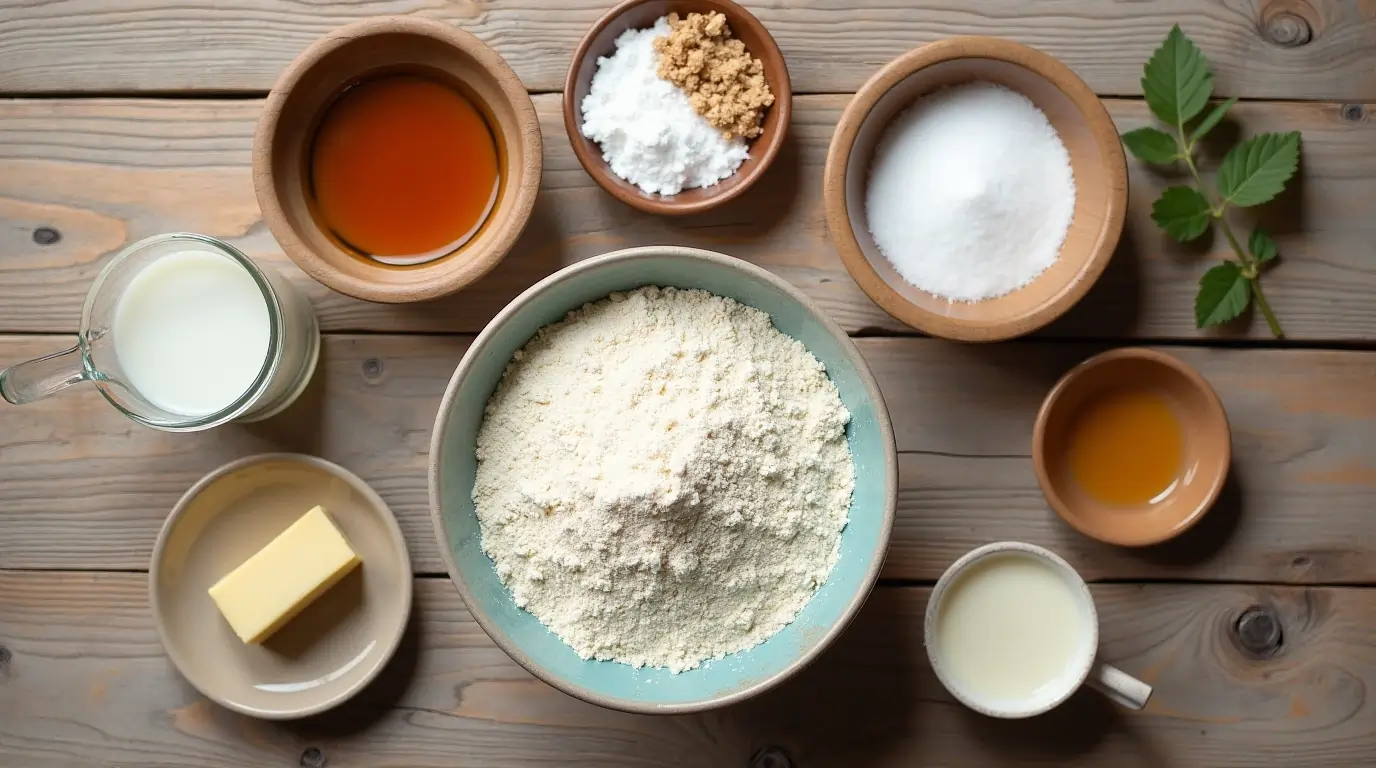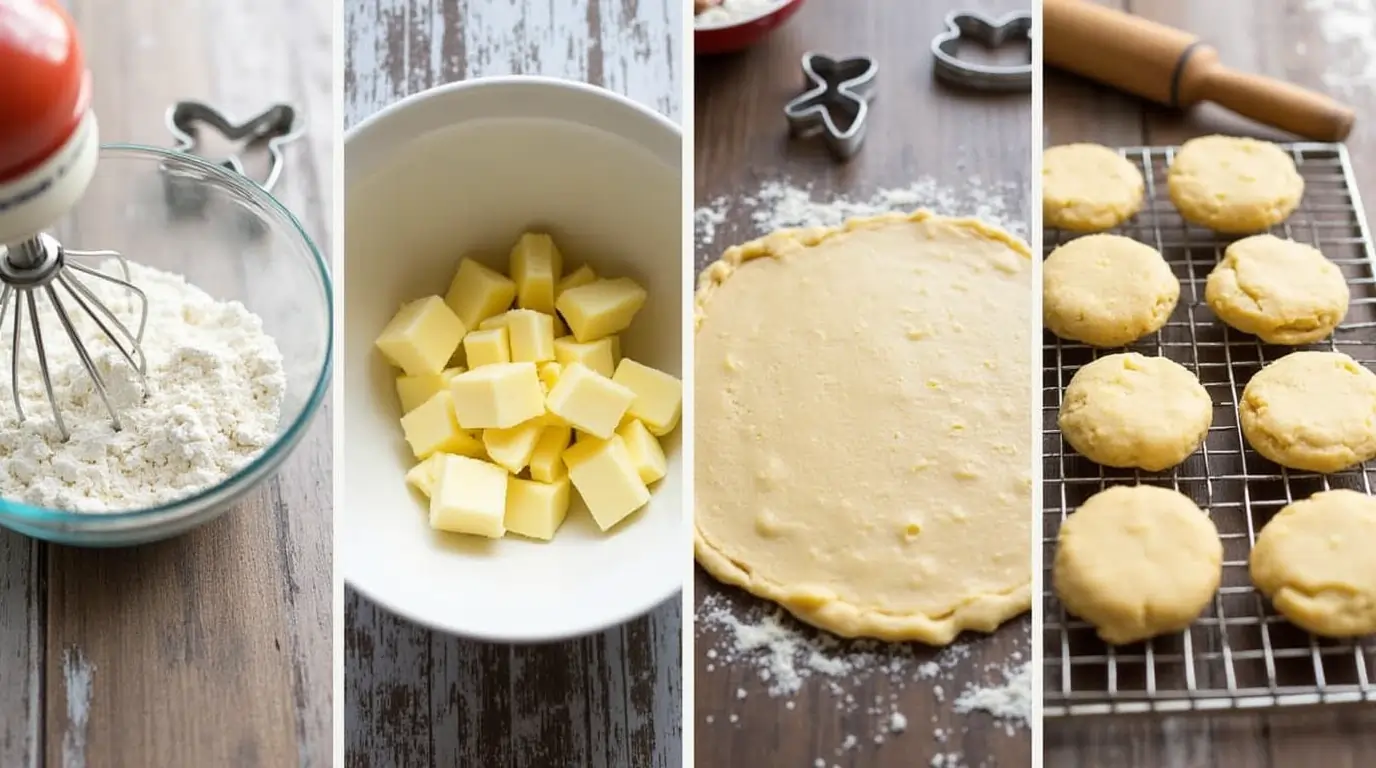Who doesn’t love a classic sugar cookie? But if you’re following a gluten-free diet, finding the perfect gluten-free sugar cookie recipe can be tricky. The good news? You don’t have to miss out on soft, chewy, and delicious sugar cookies just because you’re avoiding gluten!
In this recipe, you’ll learn how to make perfectly sweet and buttery gluten-free sugar cookies that taste just as good—if not better—than traditional ones. Whether you’re baking for a holiday, a birthday, or just a sweet craving, this easy gluten-free sugar cookie recipe is a must-try.
✨ What makes this recipe special?
✔️ Soft & chewy texture – No dry or crumbly cookies here!
✔️ No chilling required – Bake them right away!
✔️ Dairy-free & nut-free options – Customize it to fit your needs.
✔️ Perfect for cut-out cookies – Great for decorating!
Pair these delicious gluten-free sugar cookies with a refreshing Pineapple Juice Smoothie with Strawberries for the perfect balance of sweetness and freshness!
Ready to bake the best gluten-free sugar cookies ever? Let’s get started! 🍪✨
Why You’ll Love This Gluten-Free Sugar Cookie Recipe
Finding the perfect gluten-free sugar cookie recipe can be a challenge, but this one checks all the boxes for taste, texture, and ease of preparation. Whether you’re baking for yourself, your family, or a special occasion, these cookies will quickly become a go-to treat. Here’s why you’ll love them:
1. Soft & Chewy Texture
One of the biggest struggles with gluten-free cookies is avoiding a dry, crumbly texture. This recipe uses the right balance of gluten-free flour, xanthan gum, and moisture-rich ingredients to create cookies that stay soft in the center while having a slightly crisp edge.
2. Easy to Make – No-Chill Dough
Some sugar cookie recipes require chilling the dough for hours before baking, but not this one. You can mix, roll, and bake these cookies right away, making them perfect for last-minute cravings or quick baking sessions.
3. Customizable for Any Diet
Whether you need dairy-free, egg-free, or nut-free options, this recipe is easy to adapt. You can use coconut oil instead of butter, a flax egg instead of a regular egg, or oat flour instead of almond flour. No matter your dietary needs, you can still enjoy delicious sugar cookies.
4. Perfect for Cut-Out Cookies & Decorating
If you love decorating cookies for the holidays, birthdays, or special occasions, this recipe is perfect. The dough rolls out easily and holds its shape well, making it ideal for cut-out cookies. Plus, they pair beautifully with royal icing, buttercream frosting, or a simple powdered sugar glaze.
5. Naturally Gluten-Free Without Compromising Taste
You won’t have to worry about these cookies tasting “off” or different from traditional sugar cookies. The combination of vanilla extract, almond flour, and the right blend of gluten-free ingredients ensures that every bite is just as delicious as the classic version.
No matter the occasion, these gluten-free sugar cookies will impress with their flavor, texture, and versatility. Now, let’s look at the essential ingredients that make them so special.
Ingredients You Need for Gluten-Free Sugar Cookies
To make the best gluten-free sugar cookie recipe, you’ll need a combination of gluten-free flour blends, natural sweeteners, and texture-enhancing ingredients. Unlike traditional sugar cookies, these require a few key substitutes to achieve the same soft, chewy, and buttery consistency. Here’s a detailed look at the key ingredients and their importance in this recipe:

1. Gluten-Free Flour Choices
Since regular wheat flour contains gluten, you’ll need a high-quality gluten-free flour blend that mimics its properties. The right flour mix ensures your cookies hold together while staying soft and tender. Here are some common options:
| Flour Type | Best For | Notes |
|---|---|---|
| Gluten-Free All-Purpose Flour | Most reliable substitute for wheat flour | Look for blends with xanthan gum for better texture |
| Almond Flour | Adds richness and a slightly nutty flavor | Works best when combined with another GF flour |
| Coconut Flour | Absorbs moisture well, requires more liquid | Not recommended as the sole flour |
| Oat Flour | Mild, neutral taste with a soft texture | Make sure to use certified gluten-free oats |
Most store-bought gluten-free flour blends work well, especially those containing xanthan gum or guar gum, which help provide elasticity and prevent crumbling.
2. Sweeteners & Flavor Enhancers
Traditional sugar cookies are known for their sweet, slightly buttery taste, and these ingredients help achieve that classic flavor:
- Granulated Sugar or Coconut Sugar – Adds sweetness and helps create a light texture.
- Vanilla Extract & Almond Extract – Enhances the flavor and gives cookies a warm, aromatic taste.
- Maple Syrup or Honey (Optional) – A natural way to add moisture and subtle sweetness.
If you prefer a sugar-free version, you can substitute monk fruit sweetener or erythritol without compromising the taste.
3. Binding & Texture Enhancers
Since gluten is responsible for elasticity in traditional cookies, you’ll need ingredients that help hold everything together and provide a chewy texture:
- Xanthan Gum or Psyllium Husk Powder – Essential for giving structure to gluten-free dough.
- Baking Powder & Baking Soda – Helps the cookies rise slightly and maintain a soft center.
- Cornstarch or Arrowroot Powder – Adds tenderness and prevents the cookies from becoming too dense.
4. Healthy Fat Choices
Butter is a staple in sugar cookies, but for a dairy-free alternative, you can swap it with:
- Coconut Oil – Gives a slight coconut flavor but keeps the cookies moist.
- Vegan Butter – Works as a direct substitute for dairy butter.
- Ghee – A lactose-free option that still provides a buttery taste.
The choice of fat can slightly alter the texture and flavor, but all of these options will still produce delicious results.
5. Dairy-Free & Egg-Free Alternatives (If Needed)
For those with dietary restrictions, these substitutions work well:
- Dairy-Free: Replace milk-based ingredients with almond milk, coconut milk, or oat milk.
- Egg-Free: Use a flax egg (1 tbsp flaxseed meal + 3 tbsp water) or unsweetened applesauce for binding.
Final Thoughts
By selecting the right combination of these ingredients, you’ll achieve soft, flavorful, and perfectly textured gluten-free sugar cookies. Now that you know what goes into making them, let’s move on to the step-by-step process of bringing this recipe to life.
Step-by-Step: How to Make Gluten-Free Sugar Cookie Recipe
Making the perfect gluten-free sugar cookie recipe is easier than you think. With the right ingredients and a simple process, you can bake soft, delicious cookies that everyone will love. Follow this step-by-step guide to ensure your cookies turn out just right.

1. Preparing the Dough
Before you start, gather all your ingredients and preheat your oven to 350°F (175°C). Prepare a baking sheet by lining it with parchment paper to ensure the cookies don’t stick.
- Combine Dry Ingredients:
In a medium bowl, whisk together gluten-free flour, xanthan gum (if needed), baking powder, and salt. This ensures even distribution and prevents clumping. - Cream Butter and Sugar:
In a separate large bowl, use a hand mixer or stand mixer to beat butter (or coconut oil) with granulated sugar until light and fluffy. This step helps create the classic sugar cookie texture. - Add Flavor Enhancers:
Mix in vanilla extract and almond extract for a rich aroma. If you’re using a sugar-free alternative like monk fruit sweetener, ensure it dissolves well in the butter mixture. - Incorporate the Wet Ingredients:
If your recipe includes eggs, add them one at a time, beating well after each addition. For an egg-free version, use a flax egg or unsweetened applesauce. - Combine Wet and Dry Ingredients:
Slowly add the dry ingredient mixture to the wet ingredients, mixing until a soft dough forms. If the dough feels too dry, add 1-2 tablespoons of dairy-free milk (such as almond or oat milk) to reach the right consistency.
2. Rolling & Shaping the Cookies
Now that your dough is ready, it’s time to roll it out and shape your cookies:
- For Cut-Out Cookies:
- Lightly dust your work surface with gluten-free flour to prevent sticking.
- Use a rolling pin to flatten the dough to approximately ¼-inch thickness.
- Cut the dough into desired shapes using cookie cutters, then carefully place them onto the prepared baking sheet.
- For Drop Cookies (No-Chill Option):
- Drop tablespoon-sized portions of dough onto the lined baking sheet, spacing them evenly apart.
- Gently flatten each cookie with the back of a spoon or your palm.
Tip: If your dough is too soft to roll out, refrigerate it for 15–30 minutes to firm it up.
3. Baking for Perfection
Now it’s time to bake your cookies to golden perfection:
- Place the baking sheet in the preheated oven (350°F/175°C) and bake for 10-12 minutes.
- The cookies are done when the edges turn light golden brown but the centers still look slightly soft.
- Take the cookies out of the oven and allow them to cool on the baking sheet for about 5 minutes before moving them to a wire rack to cool completely. This helps them set properly and prevents breaking.
Tip: Avoid overbaking, as gluten-free cookies can dry out quickly.
4. Decorating (Optional but Fun!)
Once the cookies have fully cooled, you can decorate them to suit your occasion:
- Classic Sugar Coating: Sprinkle powdered sugar on top for a simple, elegant finish.
- Royal Icing: Mix powdered sugar, almond milk, and vanilla extract to create a smooth icing for decorating.
- Buttercream Frosting: For a rich, creamy topping, use dairy-free butter and powdered sugar.
If making these cookies for holidays or special occasions, add colorful sprinkles, chocolate drizzle, or a dusting of cinnamon for extra flavor.
Final Thoughts
By following these steps, you’ll achieve perfectly soft, gluten-free sugar cookies with just the right amount of sweetness. Now that you’ve mastered the baking process, let’s explore some expert tips to make them even better.
Expert Tips for Perfect Gluten-Free Sugar Cookie Recipe
Baking gluten-free sugar cookies can be tricky, especially when trying to achieve the right texture and flavor. Gluten-free dough behaves differently from traditional cookie dough, which means small adjustments can make a big difference. Here are some expert tips to help you get soft, chewy, and delicious cookies every time.
1. Use the Right Gluten-Free Flour Blend
One of the biggest factors in getting the right texture is choosing the right gluten-free flour mix. Since gluten provides elasticity in traditional baking, you need a flour blend that can mimic its properties.
Best Gluten-Free Flour Options for Sugar Cookies:
| Flour Type | Texture & Benefits | Best Use |
|---|---|---|
| Gluten-Free All-Purpose Flour | Closest to regular flour in taste and structure | Ideal for a 1:1 substitution |
| Almond Flour | Adds a rich, nutty flavor and moisture | Works best when combined with another GF flour |
| Oat Flour | Provides a soft texture and mild taste | Great for a more wholesome cookie |
| Coconut Flour | Absorbs a lot of moisture, making cookies drier | Should be used in small amounts alongside other flours |
💡 Pro Tip: If your gluten-free flour blend doesn’t include xanthan gum, add ½ teaspoon per cup of flour to help with binding and elasticity.
2. Avoid Dry & Crumbly Cookies
The gluten-free dough tends to be drier than traditional cookie dough. If your cookies turn out too crumbly, try these adjustments:
- Add moisture: A small amount of dairy-free milk, sour cream, or applesauce can prevent dryness.
- Use soft butter or coconut oil: Cold fat can make the dough harder to work with.
- Don’t overmix: Overworking the dough can make cookies tough. Mix just until combined.
- Weigh your flour: Too much flour makes cookies dense. Use a kitchen scale for accuracy.
💡 Pro Tip: If your dough seems too dry, mix in 1-2 teaspoons of almond or oat milk until you get a smooth consistency.
3. No-Chill vs. Chilled Dough – Which Is Better?
Some recipes require chilling the dough before rolling it out, while others don’t. Here’s when you should (or shouldn’t) chill your dough:
| Type of Cookie | Chilling Required? | Why? |
|---|---|---|
| Cut-Out Cookies | Yes, at least 30 minutes | Helps keep sharp shapes when baking |
| Drop Cookies | No | These cookies spread naturally without chilling |
| Thicker, Chewy Cookies | Yes, 15-20 minutes | Prevents cookies from flattening too much |
💡 Pro Tip: If your dough is too sticky to roll out, chill it for 15–30 minutes before working with it. This makes it easier to handle.
4. Bake at the Right Temperature & Time
Gluten-free cookies require slightly different baking times and temperatures compared to regular cookies.
- Bake at 350°F (175°C) for 10-12 minutes for soft cookies.
- For crispier edges, bake for an extra 2-3 minutes.
- Watch the edges – they should turn light golden brown while the center remains slightly soft.
💡 Pro Tip: If baking multiple batches, let the cookie sheet cool before placing more dough on it. A hot baking sheet can cause excess spreading.
5. Store & Freeze Cookies the Right Way
Once baked, proper storage is key to keeping your gluten-free sugar cookies fresh and soft.
Short-Term Storage:
- Keep the cookies in an airtight container at room temperature for up to five days to maintain freshness.
- Layer the cookies with parchment paper in between to prevent them from sticking together.
- If they start drying out, add a slice of bread to the container – the cookies will absorb the moisture.
Freezing Dough for Later:
- Shape dough into balls or roll it out and freeze in an airtight container.
- When ready to bake, let the dough thaw slightly at room temperature before baking.
Freezing Baked Cookies:
- Allow cookies to cool completely before freezing.
- Store in an airtight freezer bag or container for up to 3 months.
💡 Pro Tip: To refresh frozen cookies, warm them in a low-temperature oven (300°F) for 5 minutes before serving.

Final Thoughts
Mastering the perfect gluten-free sugar cookie recipe is all about using the right ingredients, maintaining moisture, and adjusting your baking techniques. Whether you love them soft, chewy, or decorated for special occasions, these tips will help you achieve bakery-quality cookies every time.
Many people choose to go gluten-free for health reasons, but it’s important to understand the potential benefits and drawbacks. Learn more from this in-depth guide by Harvard’s Nutrition Source on gluten and its role in a balanced diet.
Now that you’ve learned these expert tricks, let’s explore how you can customize these cookies to fit different dietary preferences and flavor variations.
Variations & Substitutions for This Recipe
One of the best things about this gluten-free sugar cookie recipe is its flexibility. Whether you’re looking to make the cookies dairy-free, sugar-free, egg-free, or nut-free, there are plenty of simple ingredient swaps that will allow you to customize them to fit your dietary needs. Below are some delicious variations and substitutions to try.
Dairy-Free & Vegan Option
If you’re avoiding dairy, you don’t have to sacrifice flavor or texture. Instead of butter, use coconut oil or vegan butter in a 1:1 ratio. Coconut oil gives a slight coconut flavor, while vegan butter keeps the taste more neutral. For added moisture, use almond milk, oat milk, or coconut milk instead of regular milk, adding one to two tablespoons if the dough feels too dry. If making the cookies completely vegan, replace the egg with a flax egg (1 tablespoon flaxseed meal + 3 tablespoons water) or unsweetened applesauce to help bind the dough while keeping the texture soft.
Sugar-Free Version
For those watching their sugar intake, this recipe can easily be modified to be sugar-free without losing its classic sweetness. Replace granulated sugar with monk fruit sweetener, erythritol, or coconut sugar for a lower glycemic alternative. If using a liquid sweetener like honey or maple syrup, reduce any added milk slightly to prevent the dough from becoming too soft. Powdered monk fruit sweetener can also be used to make sugar-free frosting for decorating.
Nut-Free Alternative
Many gluten-free flour blends include almond flour, but if you’re allergic to nuts, there are several ways to adjust the recipe. Use gluten-free all-purpose flour or oat flour instead of almond flour for a nut-free version. Oat flour gives a soft and slightly chewy texture, while gluten-free all-purpose flour mimics traditional wheat flour the best. If using oat flour, make sure it’s certified gluten-free to avoid cross-contamination.
Flavored Variations
If you want to add a unique twist to your cookies, there are several fun ways to enhance the flavor. For a citrus variation, add zest from a lemon or orange to the dough for a bright, refreshing taste. To create chocolate sugar cookies, replace ¼ cup of the flour with unsweetened cocoa powder. If you enjoy warm spice flavors, try mixing in ½ teaspoon of cinnamon, nutmeg, or cardamom to give the cookies a festive feel.
Texture Modifications
For softer cookies, add 1 tablespoon of sour cream or Greek yogurt to the dough to keep the cookies extra moist. If you prefer a crispier sugar cookie, increase the baking time by one to two minutes and roll the dough slightly thinner before cutting. For a chewier consistency, use brown sugar instead of white sugar, as it retains more moisture during baking.
No matter what dietary preferences or flavor preferences you have, this gluten-free sugar cookie recipe can be easily customized to suit your needs. Now that you know how to personalize them, let’s go over some frequently asked questions to ensure perfect cookies every time.
Love baking? After making these soft and chewy gluten-free sugar cookies, try our rich and creamy Boston Creme Cupcakes for another irresistible treat!
Frequently Asked Questions About Gluten-Free Sugar Cookie Recipe
1. Can I make this gluten-free sugar cookie recipe without xanthan gum?
Yes! If your gluten-free flour blend doesn’t contain xanthan gum, you can substitute it with ½ teaspoon of psyllium husk powder or ground flaxseed per cup of flour to help bind the dough.
2. How do I prevent my gluten-free sugar cookies from being too dry?
Gluten-free dough tends to be drier than regular dough. To prevent dryness, add 1-2 teaspoons of dairy-free milk or a bit of applesauce to the dough. Also, avoid overbaking, as gluten-free cookies dry out quickly.
3. Can I use almond flour alone for this gluten-free sugar cookie recipe?
No, almond flour alone won’t provide the right structure for these cookies. It’s best to mix it with gluten-free all-purpose flour or oat flour for better texture and stability.
4. Do I need to chill the dough before baking?
For cut-out cookies, chilling the dough for 30 minutes helps the cookies hold their shape. For drop cookies, chilling is not necessary, and you can bake them right away.
5. Can I freeze the dough or baked cookies?
Yes! You can freeze the dough for up to 3 months and bake it straight from the freezer (just add an extra minute to the baking time). Baked cookies can also be stored in an airtight container in the freezer for up to 3 months.
6. How do I make this gluten-free sugar cookie recipe dairy-free?
Replace butter with coconut oil or vegan butter and use almond milk, oat milk, or coconut milk instead of dairy milk. These swaps maintain the same soft texture and delicious taste.
7. Can I decorate these cookies?
Absolutely! These gluten-free sugar cookies work great with royal icing, buttercream frosting, or a simple powdered sugar glaze. Let the cookies cool completely before decorating to avoid melting the icing.
This gluten-free sugar cookie recipe is versatile, easy to make, and perfect for any occasion. Now, it’s time to get baking and enjoy a delicious homemade treat!
Conclusion
Baking the perfect gluten-free sugar cookie recipe doesn’t have to be complicated. With the right ingredients, a few simple techniques, and the flexibility to adjust for different dietary needs, you can enjoy soft, sweet, and delicious cookies that taste just like the classic version whether you’re making them for a holiday, a special occasion, or just because, these cookies are sure to be a hit with family and friends.
Now that you have everything you need to bake these amazing gluten-free sugar cookies, it’s time to preheat your oven and start creating! Don’t forget to have fun with the process, experiment with different flavors, and decorate them however you like.
If you enjoyed these gluten-free sugar cookies, why not try making a rich and creamy Cheesecake? It’s an easy and indulgent dessert that’s perfect for any occasion!
Chef’s Note
For the best results, always measure your ingredients carefully, especially gluten-free flour, as too much can make the cookies dry. If you prefer a softer cookie, try adding a touch of dairy-free milk or sour cream to keep them moist. Remember, every oven bakes differently, so keep an eye on your cookies and adjust the baking time as needed.
Leave a Review & Share Your Experience
Tried this gluten-free sugar cookie recipe? We’d love to hear from you! Leave a review and let us know how your cookies turned out. If you made any fun variations or creative decorations, share your experience in the comments. Your feedback helps others bake with confidence!
Happy baking! 🍪
We’d love to hear from you! Your reviews help us grow and bring you even better content. Share your thoughts and let others know what you think. 🌟 Leave a review today! 🙌
There are no reviews yet. Be the first one to write one.




